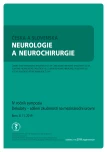Quality of life in patient with non-healing wounds
Authors:
L. Krupová 1,2; A. Pokorná 3
Authors place of work:
Kožní oddělení, FN Ostrava
1; Ústav ošetřovatelství a porodní asistence, LF Ostravská univerzita, Ostrava
2; Katedra ošetřovatelství a porodní asistence, LF MU, Brno
3
Published in the journal:
Cesk Slov Neurol N 2019; 82(Supplementum 1): 40-43
Category:
Původní práce
doi:
https://doi.org/10.14735/amcsnn2019S40
Summary
Aim: The aim of the study was to document and analyze the quality of life (QoL) of a group of hospitalized patients with non-healing wounds by type of wound and to interpret the results of studies on QoL in patients with non-healing wounds.
Materials and methods: Prospective cross-sectional study in patients with non-healing wounds in the University Hospital Ostrava (September 2017–October 2018). The QoL assessment was carried out using the Wound-QoL questionnaire, filled on admission to hospital and 7th day of hospitalization. Data analysis was performed by Microsoft Excel and IBM SPSS software (significance level 0.05).
Results: 262 questionnaires were filled in 191 patients. 246 (100%) questionnaires (191 [77.6%] of primary assessments and 55 [22.4%] of assessments on 7th day of hospitalization) were used after the exclusion of inadequately filled in forms. The QoL was quantified using the global score of the Wound-QoL.
Conclusion: The study showed that the quality of life of patients with non-healing wounds varied according to the type of wound in primary assessment. The worst global score was found in patients with diabetic foot syndrome. The QoL did not differ between men and women in primary assessment. Wound-QoL has been proven to be an effective, easy-to-use and easy-to-evaluate tool for assessing the quality of life of patients with non-healing wounds in the study.
Supported by Ministry of Health, Czech Republic – conceptual development of research organization (FNOs/ 2017).
Keywords:
Quality of life – Chronic wounds – non-healing wounds – Wound-QoL
Zdroje
1. Stryja J, Krawczyk P, Hájek M et al. Repetitorium hojení ran. 2. vyd. Semily: GEUM 2016.
2. Pokorná A, Benešová K, Mužík J et al. Data sources for monitoring of non-healing wounds in a National Health Information System – epidemiology of non-healing wounds – analysis of the National Register of hospitalized patients in 2007–2015. Cesk Slov Neurol N 2017; 80/ 113 (Suppl 1): 8–17 doi: 10.14735/ amcsnn2017S8.
3. Woo K, Conceição VL, Alam T. Optimising quality of life for people with non-healing wounds. Wounds Int 2018; 9 : 6–14.
4. Augustin M, Langenbruch AK, Herberger K et al. Quality of life measurement in chronic wounds and inflammatory skin diseases: definitions, standards and instruments. Wound Med 2014; 5 : 29–38. doi: 10.1016/ j.wndm.2014.04.008.
5. Olsson M, Järbrink K, Divakar U et al. The humanistic and economic burden of chronic wounds: a systematic review. Wound Repair and Regen 2019; 27(1): 114–125. doi: 10.1111/ wrr.12683.
6. Romić R, Brtan A, Cvitanović I et al. Quality of life and perception of disease in patients with chronic leg ulcer. Acta Clin Croat 2015; 54(3): 309–314.
7. Santos VL, Oliveira AD, Amaral AF et al. Quality of life in patients with chronic wounds: magnitude of changesand predictive factors. Rev Esc Enferm USP 2017; 51: e03250. doi: 10.1590/ S1980-220X2016049603250.
8. Lentsck MH, Baratieri T, Trincaus MR et al. Quality of life related to clinical aspects in people with chronic wound. Rev Esc Enferm USP 2018; 52: e03384. doi: 10.1590/ S1980-220X2017004003384.
9. Gonzalez de la Torre H, Quintana-Lorenzo ML, Perdomo-Pérez E et al. Correlation between health-related quality of life and venous leg ulcer‘s severity and characteristics: a cross-sectional study: a cross-sectional study. Int Wound J 2017; 14(2): 360–368. doi: 10.1111/ iwj.12610.
10. Augustin M, Baade K, Herberger K et al. Use of the Wound-QoL instrument in routine practice: feasibility, validity and development of an implementation tool. Wound Med 2014; 5 : 4–8. doi: 10.1016/ j.wndm.2014.04.001.
11. Blome C, Baade K, Sebastian Debus E et al. The “Wound-QoL”: A short questionnaire measuring quality of life in patients with chronic wounds based on three established disease-specific instruments. Wound Repair Regen 2014; 22(4): 504–514. doi: 10.1111/ wrr.12193.
Štítky
Detská neurológia Neurochirurgia NeurológiaČlánok vyšiel v časopise
Česká a slovenská neurologie a neurochirurgie

2019 Číslo Supplementum 1
- Metamizol jako analgetikum první volby: kdy, pro koho, jak a proč?
- CIDP: epidemiológia, klinický obraz a diagnostika v kocke
- Aktuálne možnosti terapie chronickej zápalovej demyelinizačnej polyradikuloneuropatie (CIDP)
- Fixní kombinace paracetamol/kodein nabízí synergické analgetické účinky
- Kombinace metamizol/paracetamol v léčbě pooperační bolesti u zákroků v rámci jednodenní chirurgie
Najčítanejšie v tomto čísle
- Kvalita života pacientů s nehojící se ranou
- Znalosti a zvyklosti všeobecných sester v prevenci ran v souvislosti se zdravotnickými prostředky v intenzivní péči – dotazníkový průzkum
- Využití podtlakové terapie k řešení ranných komplikací po angiochirurgických výkonech
- Podtlaková léčba u pacienta s dekubitem a paraplegií
